49002 Managing Projects: Stakeholder Management Report Analysis
VerifiedAdded on 2022/09/07
|8
|1872
|19
Report
AI Summary
This report provides a comprehensive overview of stakeholder management in projects. It begins by defining stakeholders and explaining their importance, referencing relevant literature. The report then delves into the stakeholder register, detailing its purpose, benefits, and format, along with a template. A significant portion is dedicated to the stakeholder prioritization grid, also known as the power-interest grid, explaining its layout, quadrants, and utility in managing stakeholders with varying levels of influence and interest. The report further explores the stakeholder communication plan, outlining its importance and providing a template for effective communication strategies. The report emphasizes the continuous nature of stakeholder identification and the importance of adapting strategies based on the evolving power and interest levels of stakeholders. The report also references various sources to provide a comprehensive analysis of the topic.

Stakeholder
Background and Rationale
As Ackermann et al 1 A stakeholder is an individual, a group of individuals or even an organization that has a vested
interest in the way a project will turn out to be. It is important to note that project stakeholders can either be directly
involved in the project or can have interests in the project that may be affected by the outcome of the project. Project
Stakeholders may include but are not limited to; the project team members, project users, project customers, project
sponsors, the project management team as well as the project 1executives.
Importance of Project Stakeholders
They are either the full project sponsors or make occasional contributions in the course of the project,
therefore they act as the project sponsors or main contributors as per Beringer et al 4.
The project manager has the task of identifying the project stakeholders’ main interest in the project and
ensures that those interests are met as the project goes on. It is worth noting that project stakeholders have
the capacity of derailing the project either passively or actively.
Managing project stakeholders is essential for the eventual success or failure of the project.
Stakeholder Register
As per Cots et al 5 A stakeholder register can be defined as that document that bests describes who is affected by the
project that is either individually or in a group, their effect and impact that they can have on the project. It can also
be defined as the project document that contains all the information required regarding the project stakeholders. It is
crucial for the project manager to complete the project stakeholder register early so as to ensure that the project
stakeholders are properly engaged in the course of the project as per Lock 92.
1 Ackermann, Fran, and Colin Eden. "Strategic management of stakeholders: Theory and practice." Long range
planning 44, no. 3 (2011): 179-196.
29 Lock, Mr Dennis. The essentials of project management. Ashgate Publishing, Ltd., 2014.
Background and Rationale
As Ackermann et al 1 A stakeholder is an individual, a group of individuals or even an organization that has a vested
interest in the way a project will turn out to be. It is important to note that project stakeholders can either be directly
involved in the project or can have interests in the project that may be affected by the outcome of the project. Project
Stakeholders may include but are not limited to; the project team members, project users, project customers, project
sponsors, the project management team as well as the project 1executives.
Importance of Project Stakeholders
They are either the full project sponsors or make occasional contributions in the course of the project,
therefore they act as the project sponsors or main contributors as per Beringer et al 4.
The project manager has the task of identifying the project stakeholders’ main interest in the project and
ensures that those interests are met as the project goes on. It is worth noting that project stakeholders have
the capacity of derailing the project either passively or actively.
Managing project stakeholders is essential for the eventual success or failure of the project.
Stakeholder Register
As per Cots et al 5 A stakeholder register can be defined as that document that bests describes who is affected by the
project that is either individually or in a group, their effect and impact that they can have on the project. It can also
be defined as the project document that contains all the information required regarding the project stakeholders. It is
crucial for the project manager to complete the project stakeholder register early so as to ensure that the project
stakeholders are properly engaged in the course of the project as per Lock 92.
1 Ackermann, Fran, and Colin Eden. "Strategic management of stakeholders: Theory and practice." Long range
planning 44, no. 3 (2011): 179-196.
29 Lock, Mr Dennis. The essentials of project management. Ashgate Publishing, Ltd., 2014.
Paraphrase This Document
Need a fresh take? Get an instant paraphrase of this document with our AI Paraphraser
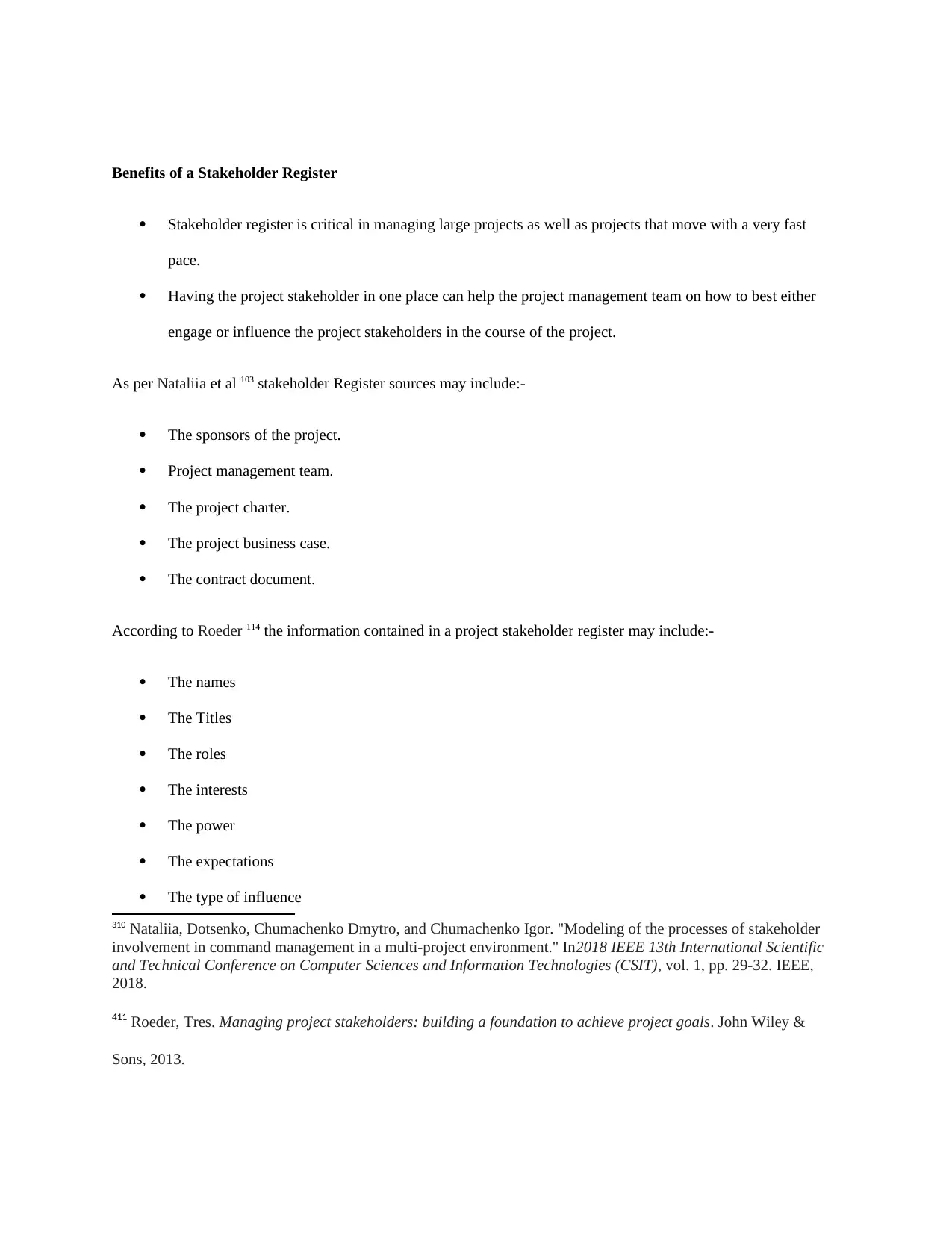
Benefits of a Stakeholder Register
Stakeholder register is critical in managing large projects as well as projects that move with a very fast
pace.
Having the project stakeholder in one place can help the project management team on how to best either
engage or influence the project stakeholders in the course of the project.
As per Nataliia et al 103 stakeholder Register sources may include:-
The sponsors of the project.
Project management team.
The project charter.
The project business case.
The contract document.
According to Roeder 114 the information contained in a project stakeholder register may include:-
The names
The Titles
The roles
The interests
The power
The expectations
The type of influence
310 Nataliia, Dotsenko, Chumachenko Dmytro, and Chumachenko Igor. "Modeling of the processes of stakeholder
involvement in command management in a multi-project environment." In2018 IEEE 13th International Scientific
and Technical Conference on Computer Sciences and Information Technologies (CSIT), vol. 1, pp. 29-32. IEEE,
2018.
411 Roeder, Tres. Managing project stakeholders: building a foundation to achieve project goals. John Wiley &
Sons, 2013.
Stakeholder register is critical in managing large projects as well as projects that move with a very fast
pace.
Having the project stakeholder in one place can help the project management team on how to best either
engage or influence the project stakeholders in the course of the project.
As per Nataliia et al 103 stakeholder Register sources may include:-
The sponsors of the project.
Project management team.
The project charter.
The project business case.
The contract document.
According to Roeder 114 the information contained in a project stakeholder register may include:-
The names
The Titles
The roles
The interests
The power
The expectations
The type of influence
310 Nataliia, Dotsenko, Chumachenko Dmytro, and Chumachenko Igor. "Modeling of the processes of stakeholder
involvement in command management in a multi-project environment." In2018 IEEE 13th International Scientific
and Technical Conference on Computer Sciences and Information Technologies (CSIT), vol. 1, pp. 29-32. IEEE,
2018.
411 Roeder, Tres. Managing project stakeholders: building a foundation to achieve project goals. John Wiley &
Sons, 2013.
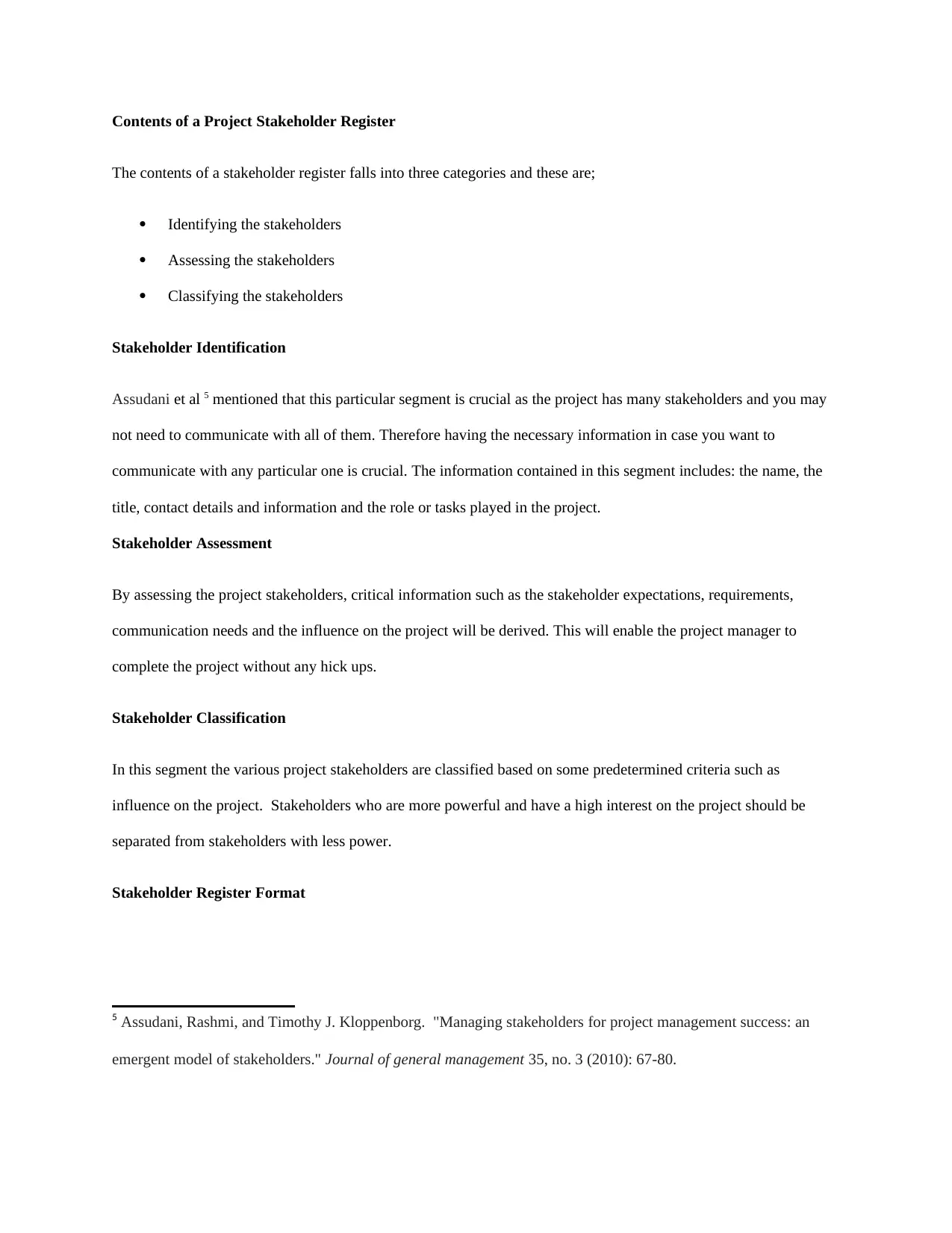
Contents of a Project Stakeholder Register
The contents of a stakeholder register falls into three categories and these are;
Identifying the stakeholders
Assessing the stakeholders
Classifying the stakeholders
Stakeholder Identification
Assudani et al 5 mentioned that this particular segment is crucial as the project has many stakeholders and you may
not need to communicate with all of them. Therefore having the necessary information in case you want to
communicate with any particular one is crucial. The information contained in this segment includes: the name, the
title, contact details and information and the role or tasks played in the project.
Stakeholder Assessment
By assessing the project stakeholders, critical information such as the stakeholder expectations, requirements,
communication needs and the influence on the project will be derived. This will enable the project manager to
complete the project without any hick ups.
Stakeholder Classification
In this segment the various project stakeholders are classified based on some predetermined criteria such as
influence on the project. Stakeholders who are more powerful and have a high interest on the project should be
separated from stakeholders with less power.
Stakeholder Register Format
5 Assudani, Rashmi, and Timothy J. Kloppenborg. "Managing stakeholders for project management success: an
emergent model of stakeholders." Journal of general management 35, no. 3 (2010): 67-80.
The contents of a stakeholder register falls into three categories and these are;
Identifying the stakeholders
Assessing the stakeholders
Classifying the stakeholders
Stakeholder Identification
Assudani et al 5 mentioned that this particular segment is crucial as the project has many stakeholders and you may
not need to communicate with all of them. Therefore having the necessary information in case you want to
communicate with any particular one is crucial. The information contained in this segment includes: the name, the
title, contact details and information and the role or tasks played in the project.
Stakeholder Assessment
By assessing the project stakeholders, critical information such as the stakeholder expectations, requirements,
communication needs and the influence on the project will be derived. This will enable the project manager to
complete the project without any hick ups.
Stakeholder Classification
In this segment the various project stakeholders are classified based on some predetermined criteria such as
influence on the project. Stakeholders who are more powerful and have a high interest on the project should be
separated from stakeholders with less power.
Stakeholder Register Format
5 Assudani, Rashmi, and Timothy J. Kloppenborg. "Managing stakeholders for project management success: an
emergent model of stakeholders." Journal of general management 35, no. 3 (2010): 67-80.
⊘ This is a preview!⊘
Do you want full access?
Subscribe today to unlock all pages.

Trusted by 1+ million students worldwide

Organizations have templates for the stakeholder register and therefore need not to start from scratch when making
a stakeholder register. They only thing that they are supposed to do is to identify the project stakeholders and then
they will be able to complete the stakeholder register.
Stakeholder Register Template
STAKEHOLDER REGISTER
PROJECT NAME/TITLE:
PROJECT PHASE: DATE PREPARED:
Stakeholder
Name
Stakeholder Role Stakeholder
Requirement/Expectations
Interest
(High/Low)
Power
(High/Low)
1.
2.
3.
4.
5.
As can be seen from the above table, the stakeholder register template has columns and rows. The columns should
contain answers to specific questions. Different project or different organizations will either add or subtract columns
and rows to their templates depending on the nature of their projects. The key guideline to any specific template
should be not to make it too bulky but rather keep it short and precise.
Stakeholder Prioritization Grid
Eskerod et al 76 puts it that this simply is a tool that helps project team in categorizing stakeholders with varying
power and interest in the ongoing project. It is also known as a power interest grid and helps in identifying the
67 Eskerod, Pernille, and Anna Lund Jepsen. Project stakeholder management. Gower Publishing, Ltd., 2013.
a stakeholder register. They only thing that they are supposed to do is to identify the project stakeholders and then
they will be able to complete the stakeholder register.
Stakeholder Register Template
STAKEHOLDER REGISTER
PROJECT NAME/TITLE:
PROJECT PHASE: DATE PREPARED:
Stakeholder
Name
Stakeholder Role Stakeholder
Requirement/Expectations
Interest
(High/Low)
Power
(High/Low)
1.
2.
3.
4.
5.
As can be seen from the above table, the stakeholder register template has columns and rows. The columns should
contain answers to specific questions. Different project or different organizations will either add or subtract columns
and rows to their templates depending on the nature of their projects. The key guideline to any specific template
should be not to make it too bulky but rather keep it short and precise.
Stakeholder Prioritization Grid
Eskerod et al 76 puts it that this simply is a tool that helps project team in categorizing stakeholders with varying
power and interest in the ongoing project. It is also known as a power interest grid and helps in identifying the
67 Eskerod, Pernille, and Anna Lund Jepsen. Project stakeholder management. Gower Publishing, Ltd., 2013.
Paraphrase This Document
Need a fresh take? Get an instant paraphrase of this document with our AI Paraphraser
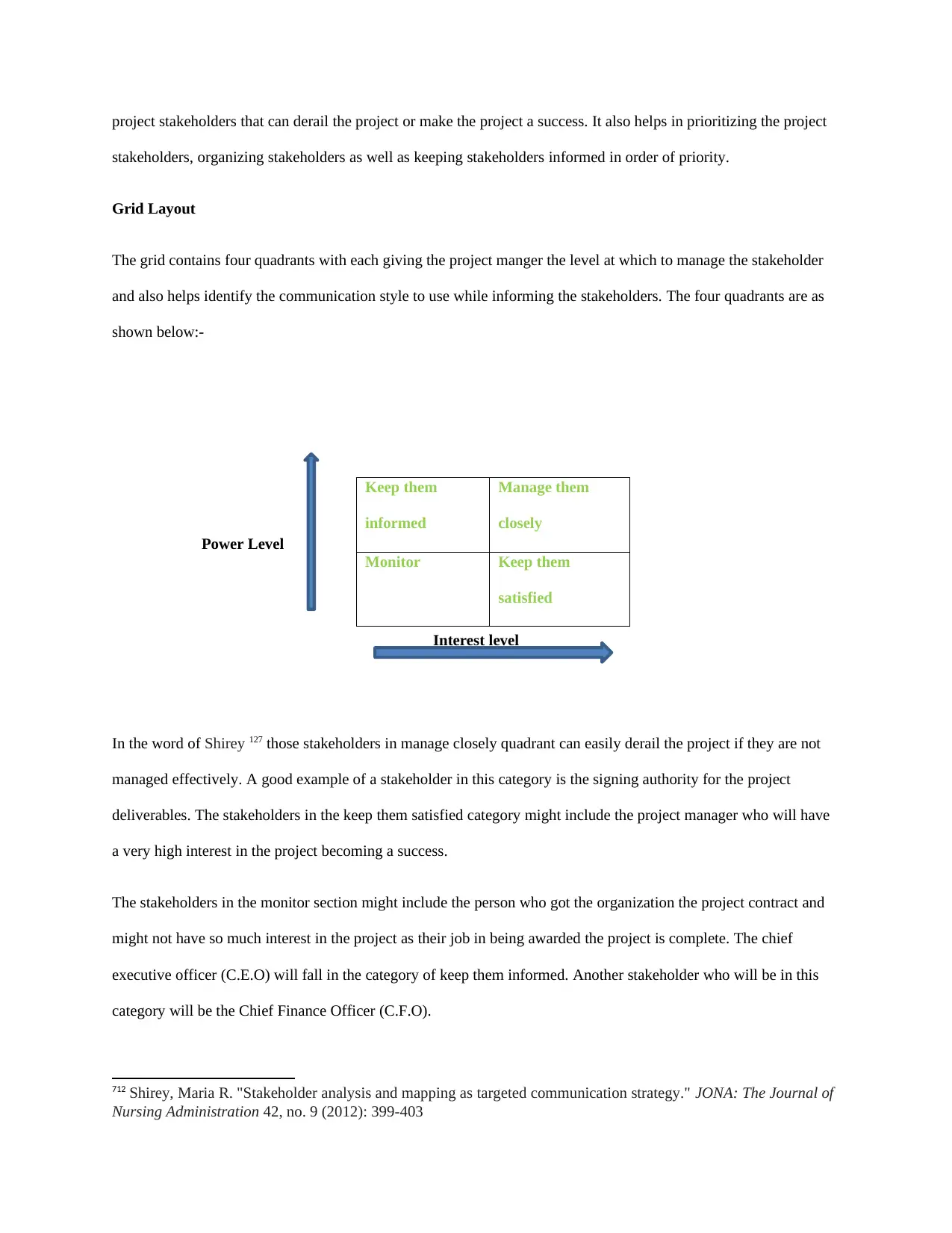
project stakeholders that can derail the project or make the project a success. It also helps in prioritizing the project
stakeholders, organizing stakeholders as well as keeping stakeholders informed in order of priority.
Grid Layout
The grid contains four quadrants with each giving the project manger the level at which to manage the stakeholder
and also helps identify the communication style to use while informing the stakeholders. The four quadrants are as
shown below:-
Power Level
Interest level
In the word of Shirey 127 those stakeholders in manage closely quadrant can easily derail the project if they are not
managed effectively. A good example of a stakeholder in this category is the signing authority for the project
deliverables. The stakeholders in the keep them satisfied category might include the project manager who will have
a very high interest in the project becoming a success.
The stakeholders in the monitor section might include the person who got the organization the project contract and
might not have so much interest in the project as their job in being awarded the project is complete. The chief
executive officer (C.E.O) will fall in the category of keep them informed. Another stakeholder who will be in this
category will be the Chief Finance Officer (C.F.O).
712 Shirey, Maria R. "Stakeholder analysis and mapping as targeted communication strategy." JONA: The Journal of
Nursing Administration 42, no. 9 (2012): 399-403
Keep them
informed
Manage them
closely
Monitor Keep them
satisfied
stakeholders, organizing stakeholders as well as keeping stakeholders informed in order of priority.
Grid Layout
The grid contains four quadrants with each giving the project manger the level at which to manage the stakeholder
and also helps identify the communication style to use while informing the stakeholders. The four quadrants are as
shown below:-
Power Level
Interest level
In the word of Shirey 127 those stakeholders in manage closely quadrant can easily derail the project if they are not
managed effectively. A good example of a stakeholder in this category is the signing authority for the project
deliverables. The stakeholders in the keep them satisfied category might include the project manager who will have
a very high interest in the project becoming a success.
The stakeholders in the monitor section might include the person who got the organization the project contract and
might not have so much interest in the project as their job in being awarded the project is complete. The chief
executive officer (C.E.O) will fall in the category of keep them informed. Another stakeholder who will be in this
category will be the Chief Finance Officer (C.F.O).
712 Shirey, Maria R. "Stakeholder analysis and mapping as targeted communication strategy." JONA: The Journal of
Nursing Administration 42, no. 9 (2012): 399-403
Keep them
informed
Manage them
closely
Monitor Keep them
satisfied
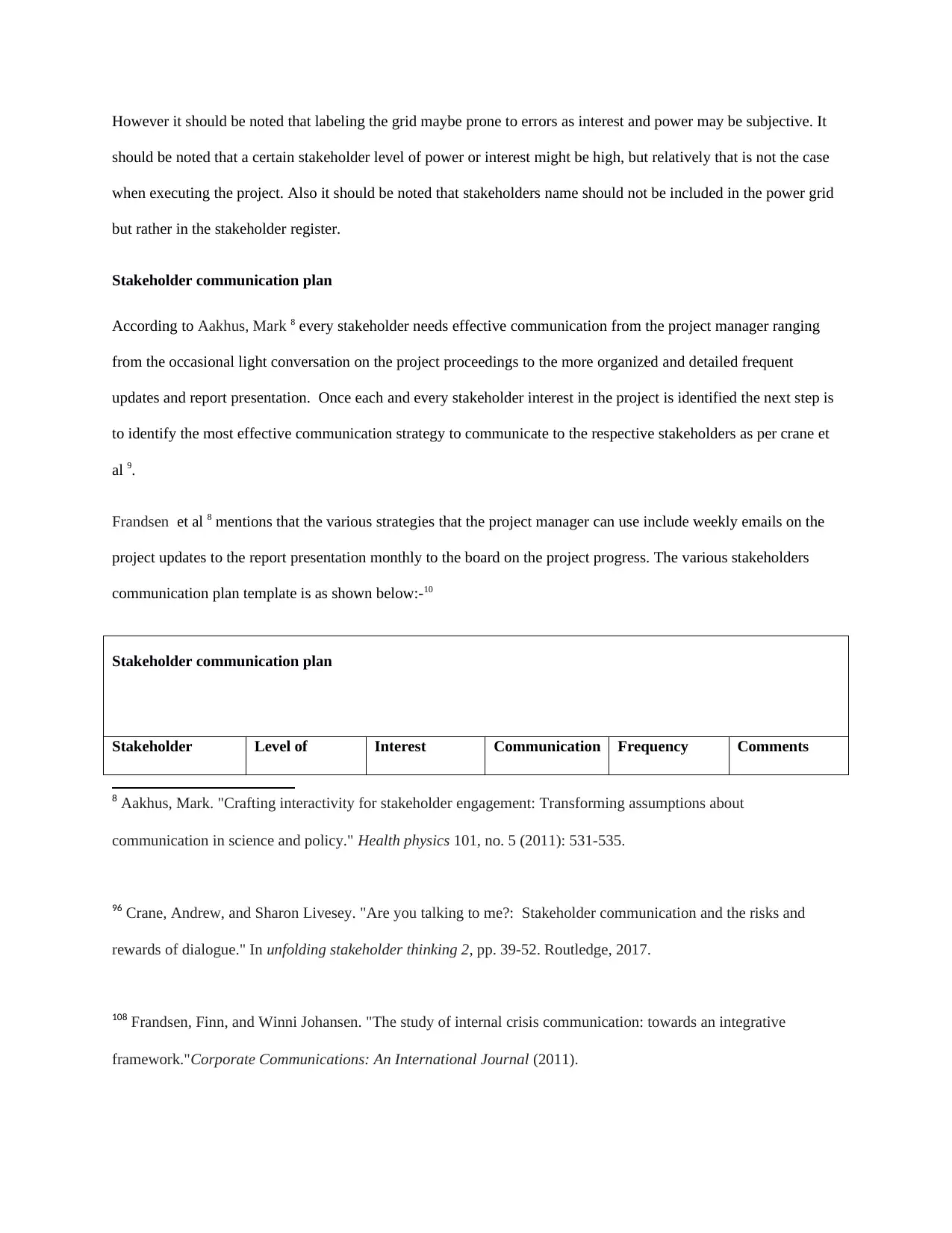
However it should be noted that labeling the grid maybe prone to errors as interest and power may be subjective. It
should be noted that a certain stakeholder level of power or interest might be high, but relatively that is not the case
when executing the project. Also it should be noted that stakeholders name should not be included in the power grid
but rather in the stakeholder register.
Stakeholder communication plan
According to Aakhus, Mark 8 every stakeholder needs effective communication from the project manager ranging
from the occasional light conversation on the project proceedings to the more organized and detailed frequent
updates and report presentation. Once each and every stakeholder interest in the project is identified the next step is
to identify the most effective communication strategy to communicate to the respective stakeholders as per crane et
al 9.
Frandsen et al 8 mentions that the various strategies that the project manager can use include weekly emails on the
project updates to the report presentation monthly to the board on the project progress. The various stakeholders
communication plan template is as shown below:-10
Stakeholder communication plan
Stakeholder Level of Interest Communication Frequency Comments
8 Aakhus, Mark. "Crafting interactivity for stakeholder engagement: Transforming assumptions about
communication in science and policy." Health physics 101, no. 5 (2011): 531-535.
96 Crane, Andrew, and Sharon Livesey. "Are you talking to me?: Stakeholder communication and the risks and
rewards of dialogue." In unfolding stakeholder thinking 2, pp. 39-52. Routledge, 2017.
108 Frandsen, Finn, and Winni Johansen. "The study of internal crisis communication: towards an integrative
framework."Corporate Communications: An International Journal (2011).
should be noted that a certain stakeholder level of power or interest might be high, but relatively that is not the case
when executing the project. Also it should be noted that stakeholders name should not be included in the power grid
but rather in the stakeholder register.
Stakeholder communication plan
According to Aakhus, Mark 8 every stakeholder needs effective communication from the project manager ranging
from the occasional light conversation on the project proceedings to the more organized and detailed frequent
updates and report presentation. Once each and every stakeholder interest in the project is identified the next step is
to identify the most effective communication strategy to communicate to the respective stakeholders as per crane et
al 9.
Frandsen et al 8 mentions that the various strategies that the project manager can use include weekly emails on the
project updates to the report presentation monthly to the board on the project progress. The various stakeholders
communication plan template is as shown below:-10
Stakeholder communication plan
Stakeholder Level of Interest Communication Frequency Comments
8 Aakhus, Mark. "Crafting interactivity for stakeholder engagement: Transforming assumptions about
communication in science and policy." Health physics 101, no. 5 (2011): 531-535.
96 Crane, Andrew, and Sharon Livesey. "Are you talking to me?: Stakeholder communication and the risks and
rewards of dialogue." In unfolding stakeholder thinking 2, pp. 39-52. Routledge, 2017.
108 Frandsen, Finn, and Winni Johansen. "The study of internal crisis communication: towards an integrative
framework."Corporate Communications: An International Journal (2011).
⊘ This is a preview!⊘
Do you want full access?
Subscribe today to unlock all pages.

Trusted by 1+ million students worldwide
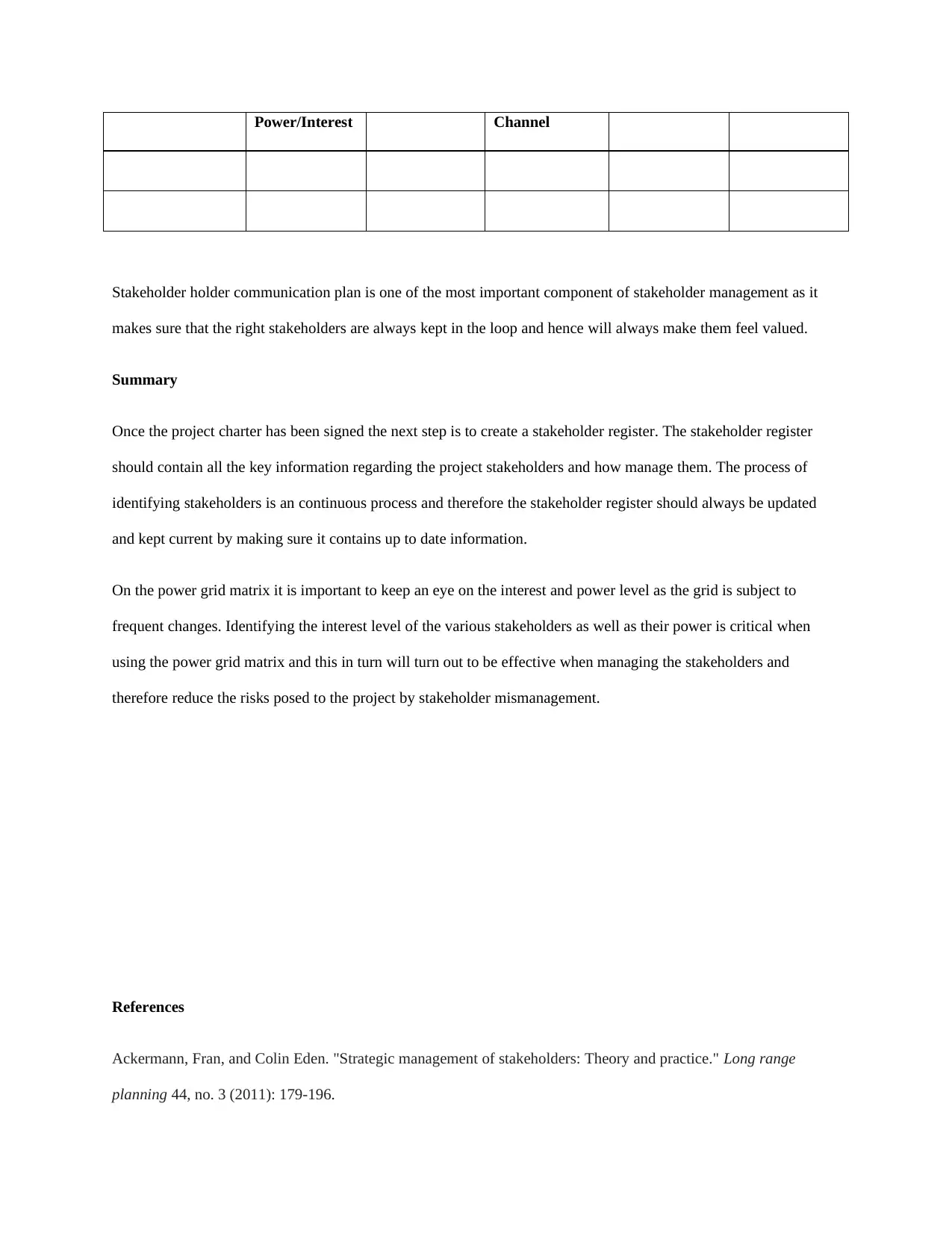
Power/Interest Channel
Stakeholder holder communication plan is one of the most important component of stakeholder management as it
makes sure that the right stakeholders are always kept in the loop and hence will always make them feel valued.
Summary
Once the project charter has been signed the next step is to create a stakeholder register. The stakeholder register
should contain all the key information regarding the project stakeholders and how manage them. The process of
identifying stakeholders is an continuous process and therefore the stakeholder register should always be updated
and kept current by making sure it contains up to date information.
On the power grid matrix it is important to keep an eye on the interest and power level as the grid is subject to
frequent changes. Identifying the interest level of the various stakeholders as well as their power is critical when
using the power grid matrix and this in turn will turn out to be effective when managing the stakeholders and
therefore reduce the risks posed to the project by stakeholder mismanagement.
References
Ackermann, Fran, and Colin Eden. "Strategic management of stakeholders: Theory and practice." Long range
planning 44, no. 3 (2011): 179-196.
Stakeholder holder communication plan is one of the most important component of stakeholder management as it
makes sure that the right stakeholders are always kept in the loop and hence will always make them feel valued.
Summary
Once the project charter has been signed the next step is to create a stakeholder register. The stakeholder register
should contain all the key information regarding the project stakeholders and how manage them. The process of
identifying stakeholders is an continuous process and therefore the stakeholder register should always be updated
and kept current by making sure it contains up to date information.
On the power grid matrix it is important to keep an eye on the interest and power level as the grid is subject to
frequent changes. Identifying the interest level of the various stakeholders as well as their power is critical when
using the power grid matrix and this in turn will turn out to be effective when managing the stakeholders and
therefore reduce the risks posed to the project by stakeholder mismanagement.
References
Ackermann, Fran, and Colin Eden. "Strategic management of stakeholders: Theory and practice." Long range
planning 44, no. 3 (2011): 179-196.
Paraphrase This Document
Need a fresh take? Get an instant paraphrase of this document with our AI Paraphraser
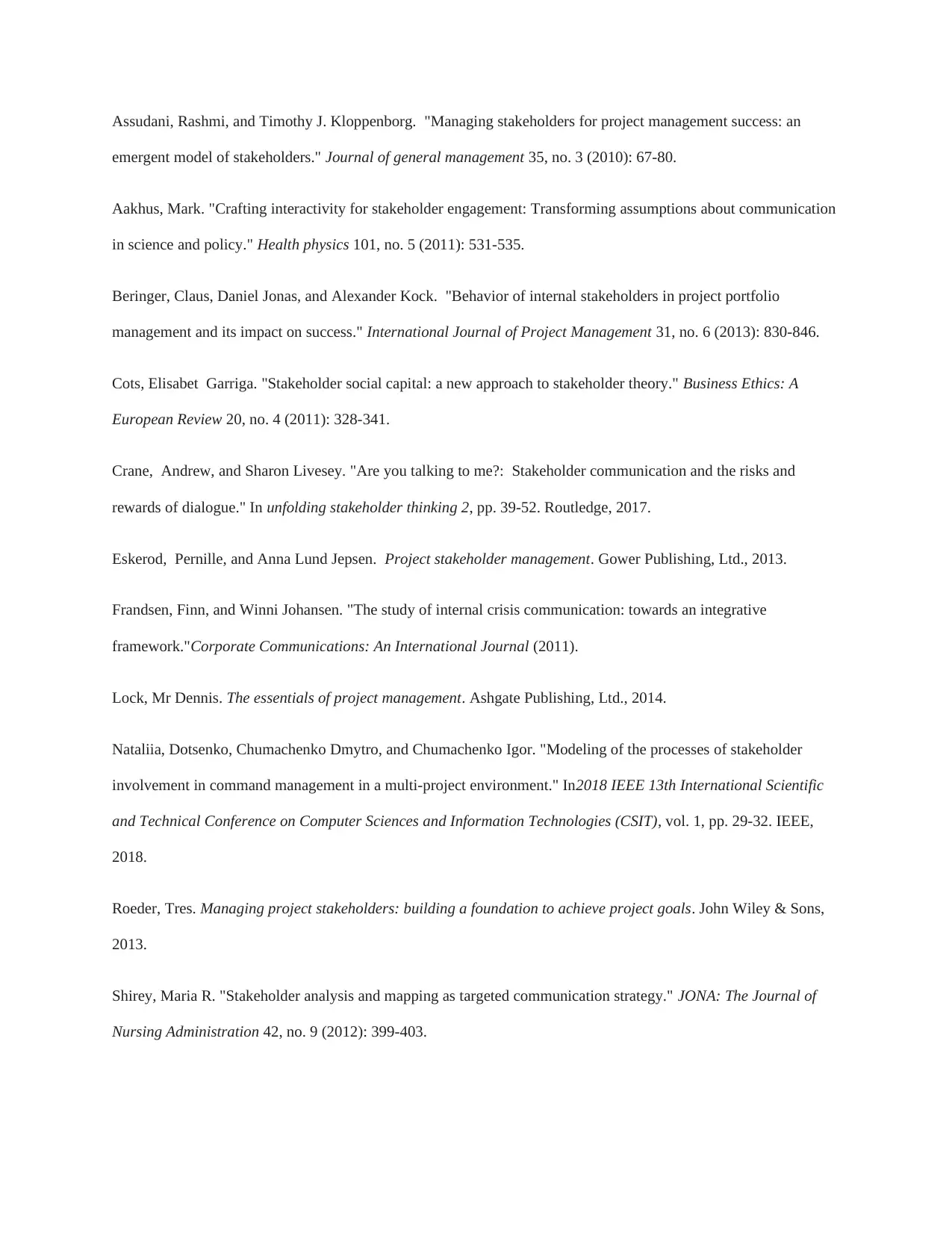
Assudani, Rashmi, and Timothy J. Kloppenborg. "Managing stakeholders for project management success: an
emergent model of stakeholders." Journal of general management 35, no. 3 (2010): 67-80.
Aakhus, Mark. "Crafting interactivity for stakeholder engagement: Transforming assumptions about communication
in science and policy." Health physics 101, no. 5 (2011): 531-535.
Beringer, Claus, Daniel Jonas, and Alexander Kock. "Behavior of internal stakeholders in project portfolio
management and its impact on success." International Journal of Project Management 31, no. 6 (2013): 830-846.
Cots, Elisabet Garriga. "Stakeholder social capital: a new approach to stakeholder theory." Business Ethics: A
European Review 20, no. 4 (2011): 328-341.
Crane, Andrew, and Sharon Livesey. "Are you talking to me?: Stakeholder communication and the risks and
rewards of dialogue." In unfolding stakeholder thinking 2, pp. 39-52. Routledge, 2017.
Eskerod, Pernille, and Anna Lund Jepsen. Project stakeholder management. Gower Publishing, Ltd., 2013.
Frandsen, Finn, and Winni Johansen. "The study of internal crisis communication: towards an integrative
framework."Corporate Communications: An International Journal (2011).
Lock, Mr Dennis. The essentials of project management. Ashgate Publishing, Ltd., 2014.
Nataliia, Dotsenko, Chumachenko Dmytro, and Chumachenko Igor. "Modeling of the processes of stakeholder
involvement in command management in a multi-project environment." In2018 IEEE 13th International Scientific
and Technical Conference on Computer Sciences and Information Technologies (CSIT), vol. 1, pp. 29-32. IEEE,
2018.
Roeder, Tres. Managing project stakeholders: building a foundation to achieve project goals. John Wiley & Sons,
2013.
Shirey, Maria R. "Stakeholder analysis and mapping as targeted communication strategy." JONA: The Journal of
Nursing Administration 42, no. 9 (2012): 399-403.
emergent model of stakeholders." Journal of general management 35, no. 3 (2010): 67-80.
Aakhus, Mark. "Crafting interactivity for stakeholder engagement: Transforming assumptions about communication
in science and policy." Health physics 101, no. 5 (2011): 531-535.
Beringer, Claus, Daniel Jonas, and Alexander Kock. "Behavior of internal stakeholders in project portfolio
management and its impact on success." International Journal of Project Management 31, no. 6 (2013): 830-846.
Cots, Elisabet Garriga. "Stakeholder social capital: a new approach to stakeholder theory." Business Ethics: A
European Review 20, no. 4 (2011): 328-341.
Crane, Andrew, and Sharon Livesey. "Are you talking to me?: Stakeholder communication and the risks and
rewards of dialogue." In unfolding stakeholder thinking 2, pp. 39-52. Routledge, 2017.
Eskerod, Pernille, and Anna Lund Jepsen. Project stakeholder management. Gower Publishing, Ltd., 2013.
Frandsen, Finn, and Winni Johansen. "The study of internal crisis communication: towards an integrative
framework."Corporate Communications: An International Journal (2011).
Lock, Mr Dennis. The essentials of project management. Ashgate Publishing, Ltd., 2014.
Nataliia, Dotsenko, Chumachenko Dmytro, and Chumachenko Igor. "Modeling of the processes of stakeholder
involvement in command management in a multi-project environment." In2018 IEEE 13th International Scientific
and Technical Conference on Computer Sciences and Information Technologies (CSIT), vol. 1, pp. 29-32. IEEE,
2018.
Roeder, Tres. Managing project stakeholders: building a foundation to achieve project goals. John Wiley & Sons,
2013.
Shirey, Maria R. "Stakeholder analysis and mapping as targeted communication strategy." JONA: The Journal of
Nursing Administration 42, no. 9 (2012): 399-403.
1 out of 8
Related Documents
Your All-in-One AI-Powered Toolkit for Academic Success.
+13062052269
info@desklib.com
Available 24*7 on WhatsApp / Email
![[object Object]](/_next/static/media/star-bottom.7253800d.svg)
Unlock your academic potential
Copyright © 2020–2025 A2Z Services. All Rights Reserved. Developed and managed by ZUCOL.





